Related Research Articles
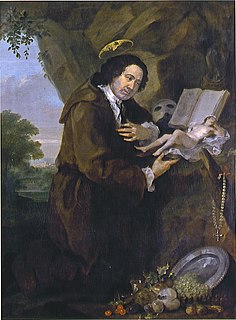
Hellfire Club was a name for several exclusive clubs for high-society rakes established in Britain and Ireland in the 18th century. The name most commonly refers to Francis Dashwood's Order of the Friars of St. Francis of Wycombe. Such clubs, rumour had it, served as the meeting places of "persons of quality" who wished to take part in what were socially perceived as immoral acts, and the members were often involved in politics. Neither the activities nor membership of the clubs are easy to ascertain. The clubs allegedly had distant ties to an elite society known only as "The Order of the Second Circle".

The AGM-114 Hellfire is an air-to-ground missile (AGM) first developed for anti-armor use, later developed for precision drone strikes against other target types, especially high-value targets. It was originally developed under the name Heliborne laser, fire-and-forget missile, which led to the colloquial name "Hellfire" ultimately becoming the missile's formal name. It has a multi-mission, multi-target precision-strike ability and can be launched from multiple air, sea, and ground platforms, including the Predator drone. The Hellfire missile is the primary 100-pound (45 kg) class air-to-ground precision weapon for the armed forces of the United States and many other nations. It has also been fielded on surface platforms in the surface-to-surface and surface-to-air roles.
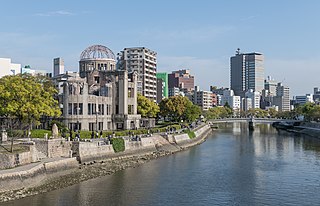
Hiroshima is the capital of Hiroshima Prefecture in Japan. As of June 1, 2019, the city had an estimated population of 1,199,391. The gross domestic product (GDP) in Greater Hiroshima, Hiroshima Urban Employment Area, was US$61.3 billion as of 2010. Kazumi Matsui has been the city's mayor since April 2011.
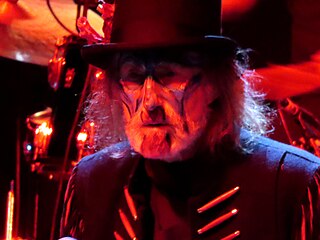
Arthur Wilton Brown is an English rock singer best known for his flamboyant and theatrical performances, eclectic work and his powerful, wide-ranging operatic voice, in particular his high pitched banshee screams. He was also notable for his unique stage persona such as extreme facepaint and burning helmet.
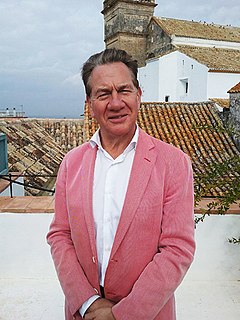
Michael Denzil Xavier Portillo is a British journalist, broadcaster and former politician. His broadcast series include railway documentaries such as Great British Railway Journeys and Great Continental Railway Journeys. A former member of the Conservative Party, he was Member of Parliament (MP) for Enfield Southgate from 1984 to 1997 and Kensington and Chelsea from 1999 to 2005.
Hellfire may refer to:

Hibakusha is a word of Japanese origin generally designating the people affected by the atomic bombings of Hiroshima and Nagasaki at the end of World War II.
John W. Dower is an American author and historian. His 1999 book Embracing Defeat: Japan in the Wake of World War II won the U.S. National Book Award for Nonfiction, the Pulitzer Prize for General Nonfiction, the Bancroft Prize, the Los Angeles Times Book Prize, the Mark Lynton History Prize, and the John K. Fairbank Prize of the American Historical Association.
Threnody to the Victims of Hiroshima, also translated as Threnody for the Victims of Hiroshima, is a musical composition for 52 string instruments composed in 1961 by Krzysztof Penderecki. Dedicated to the residents of Hiroshima killed and injured by the first-ever wartime usage of an atomic weapon, the composition won the Tribune Internationale des Compositeurs UNESCO prize that same year.

The Hiroshima Panels are a series of fifteen painted folding panels by the collaborative husband and wife artists Maruki Iri and Maruki Toshi (fr) completed over a span of thirty-two years (1950–1982). The Panels depict the consequences of the atomic bombings of Hiroshima and Nagasaki, as well as other nuclear disasters of the 20th century. Each panel stands 1.8 metres x 7.2 metres.

Hiroshima mon amour, is a 1959 romantic drama film directed by French film director Alain Resnais and with a screenplay by French author Marguerite Duras.
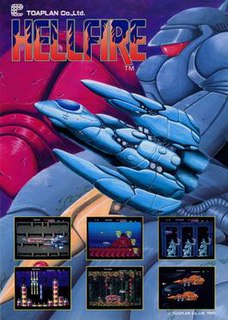
Hellfire is a 1989 horizontally scrolling shooter arcade video game originally developed by Toaplan and published in Japan by Taito and North America by U.S.A. Games. The first horizontal shoot 'em up title to be created by Toaplan, the game takes place in the year 2998 where a space matter known as Black Nebula created by robot dictator Super Mech spreads and threatens to engulf human-controlled galaxies, as players assume the role of Space Federation member Captain Lancer taking control of the CNCS1 space fighter craft in a surprise attack to overthrow the enemies with the fighter craft's titular weapon.
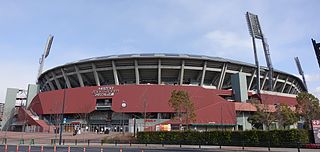
Mazda Stadium Hiroshima, also called Hiroshima Municipal Stadium, is a baseball stadium in Minami-ku, Hiroshima, Japan. It is used primarily for baseball and is the home of the Hiroshima Toyo Carp of the Japanese Central League. The ballpark has a capacity of 32,000 people and opened on April 10, 2009. It replaced First Hiroshima Municipal Stadium and initially retained the old ballpark's official name. The stadium architecture is considered to be labeled as a retro-classic ballpark.

Steven Toll Okazaki is an American documentary filmmaker known for his raw, cinéma vérité-style documentaries that frequently show ordinary people dealing with extraordinary circumstances. He has received a Peabody Award, a Primetime Emmy and has been nominated for four Academy Awards, winning an Oscar for the documentary short subject, Days of Waiting: The Life & Art of Estelle Ishigo.

The United States detonated two atomic bombs over the Japanese cities of Hiroshima and Nagasaki on 6 and 9 August 1945, respectively. The two bombings killed between 129,000 and 226,000 people, most of whom were civilians, and remain the only use of nuclear weapons in armed conflict.

A Queen Is Crowned is a 1953 British Technicolor documentary film written by Christopher Fry. The film documents the 1953 Coronation of Queen Elizabeth II, with a narration of events by Laurence Olivier. It was nominated for the Academy Award for Best Documentary Feature and was the first winner of the now-defunct Golden Globe Award for Best Documentary Film. The film was one of the most popular at the British box office in 1953.
No More Hiroshima is a 1984 National Film Board of Canada documentary about two survivors of the 1945 atomic bomb attack on Hiroshima, who are among a small group of Japanese who risk ostracism in their country by identifying themselves as hibakusha: survivors of the atomic bombings of Hiroshima and Nagasaki. The 26-minute documentary by Martin Duckworth follows the survivors on their mission to New York City as part of the Japanese peace movement at the second United Nations Special Session on Disarmament held in June, 1982. This 26 minute film received the Genie Award for Best Short Documentary at the 7th Genie Awards.
Stephen Walker is a British author and filmmaker. He was educated at Oxford and Harvard universities. He has directed or produced around 30 films, and was twice voted in the top 10 directors in the UK in Broadcast magazine. His production company is Walker George Films.
Shuntaro Hida was a Japanese physician who was an eyewitness when the Little Boy atomic bomb was dropped on Hiroshima by the Enola Gay on 6 August 1945. He treated survivors as a medical doctor and wrote about the effects of radiation on the human body.

Chris Broad, also known online as Abroad in Japan, is an English YouTuber, filmmaker, podcast host, and former Assistant Language Teacher. He focuses on the creation of videos about Japanese culture, Japanese food and travel in Japan, primarily in the Tōhoku region.
References
- ↑ "Hellfire: A Journey from Hiroshima". Sundance. Archived from the original on December 5, 2015. Retrieved March 29, 2013.
- ↑ "NY Times: Hellfire: A Journey from Hiroshima". Movies & TV Dept. The New York Times . Baseline & All Movie Guide. Archived from the original on October 14, 2012. Retrieved November 17, 2008.